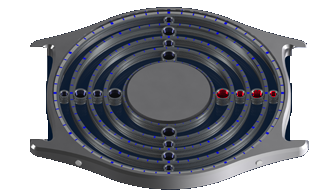Rolling-element bearings have the less friction losses and accordingly the highest efficiency among others types of rotational mechanical supports and constraining tools. Thus, the identical rolling elements acting intermediate role between inner and outer races allow them to move relatively to each other without sliding friction. However, to entirely prevent the sliding frictions the counter rotations of adjacent rolling elements should not contact, for what is using the holding rolling elements – the separating cage. In spite of lightness of this cage, it carries out purely on sliding friction of rolling elements and requires to use lubricant and structurally makes more bulky construction.
To avoid the using the cage and prevent the collisions of adjacent rolling elements it was developed several technologies and in particularly using epicyclic gear united to roller bearing. However, because of jamming by the loads, complexity of assembling and manufacturing this technology didn’t get the wide application.
Being professionally involved in modelling and investigations, I solved the aforesaid weaknesses as on kinematical as on technological level and worldwide patented that, namely in using of herringbone or skew end faces of gears, preventing warping of gears-rollers during axial interactions. The gears manufacturing complexity is solved by production in sole production step of the all gear teeth, and the assembling is supposed to use two symmetrical parts of folding inner of outer races for choice.
Bellow it is presented the section view and evolution of standard NU1008 M cylindrical roller bearing to gear bearing with skew teeth, disassembled inner race and slimmer structure, because of absence of the cage.
The similar result could be achieved by using of herringbone gearings with widen teeth cavity than protrusion their parts. Moreover, by the same way could be achieved tapered structure.
The advantages:
Has less quantity of parts;
Has entirely rolling friction principle;
The construction is more accurate;
Do not suppose the slippage the roller elements;
More constrained construction;
Could be used without lubricants;
Could be used as reduction elements;
Could have only several rollers elements;
No mutual rollers interactions;
Minimal end faces rollers to races sliding friction;
Less slippage by hard conditions;
The disadvantages:
At least one race should have demountable joint;
Need to have additional operation to manufacture the teeth;
More complex in thrust and spherical support bearings application.
For more detail about technological and licensing aspects please contact me directly throughout contact form.

The trouble with 3D printing a ball bearing is that spheres don’t adhere to the 45 degree rule, so they tend to print poorly, or if metal balls are used instead, then the bearing requires assembly. This is a new kind of bearing that can only be manufactured by 3D printing and comes preassembled.
Thank you very much for your interest of gear-bearing technology, but 3d-printing is not suited for gear bearing production because of its stepped surface forming. There is much more better, precision and efficient production way. In serial production the gear-bearing price could be similar as herringbone gears of same sizes.